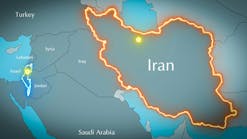But declines were expected to be short-lived.
Analysts contend strong overriding oil demand will buttress prices (see story, p. 21). Immediately after the resumption announcement, Brent and Nymex for January delivery began a slide that had totaled about $2/bbl by OGJ presstime. In Asia, prices began falling prior to announcement, but declines were seen as only temporary.
"The market has already factored in the availability of Iraqi crude," maintains Akio Shibata, general manager of Marubeni Corp.'s industrial research section.
Shibata expects Nymex light crude prices in 1997 to stay at $23-26/bbl.
Meanwhile, at a meeting of producing and consuming nations at Goa, India, OPEC producers said they're confident Brent can be sustained at about $20-25/bbl.
The meeting was attended by six OPEC ministers and officials from four of five other OPEC member nations.
OPEC Sec. Gen. Rilwanu Lukman says OPEC is satisfied with current oil price levels, and there is no need to press for higher levels
"These prices are here to stay," said another OPEC official.
Prices in recent months have inched up despite rising OPEC production, and analysts see no major change ahead in spite of Iraq's return to the market.
At the Goa meeting, Iran's Oil Minister Gholamreza Aghazadeh said his country will soon begin awarding initial contracts to international bidders covering a total of 10 offshore development projects.
First of the 10 contracts will cover redevelopment of the 60,000 b/d Kharg Island area Soroush field-damaged during the Iran-Iraq War-and the 35,000 b/d Balal field. Remaining contracts are to be let by mid-1997.
Iran says the 10 projects will require an investment of $4-5 billion.
Royal Dutch/Shell will restructure and rationalize its European refining group, including sale of its 60,000 b/d Cressier, Switzerland, refinery.
The moves, spurred by excess refining capacity squeezing profits, could mean more plant closures. Lube blending plants at Pernis, Netherlands, and Ghent, Belgium, are to be closed by yearend 1998.
The restructuring is expected to mainly affect operations in France, where Shell has 320,000 b/d of capacity in three refineries. It has 14 refineries in western Europe. A principal target could be Shell's 120,000 b/d Berre, France, refinery and petrochemical complex, where Shell is evaluating refining needs along with other refiners in a study backed by the French Ministry of Industry.
Rationalization and upgrading of lubricants plants in France and Germany are also seen as ways to create a more integrated operation and counter disappointing revenues.
Meantime, sporadic strikes by refinery workers in France have resulted from disclosure of more planned job cuts by Elf, Esso, BP/Mobil, and Shell.
Last week, strikes hit Shell and Total plants. Mobil workers were also planning to strike at presstime. A 10-day strike at three Elf refineries ended Dec. 7.
In Bolivia, Enron and Shell have been tapped by the government as the successful capitalizing companies for the pipeline business of state-owned Yacimientos Petroliferos Fiscales Bolivianos (YPFB).
With a bid of $263.5 million, the companies jointly acquired a 50% stake in all of YPFB's transportation assets, including ownership in 1,655 miles of gas pipelines, 1,438 miles of liquids pipelines, and the Bolivia-Brazil pipeline project. Remaining interests will be held by Bolivian pension funds.
Upon closing of the deal, Enron and Shell will each own a 29% interest in the Bolivian portion of the pipeline project, and Enron, Shell, and the pension funds will own 33% of the Bolivia-Brazil pipeline project.
Is Sudan finally getting closer to joining the ranks of crude oil exporters?
Calgary's Arakis Energy has disclosed formation of a group to proceed with accelerated E&D on its 12.2 million acre concession (OGJ, Sept. 20, 1993, p. 32).
Project, about 500 miles southwest of Khartoum, is valued at about $1 billion. Major project financing covering Heglig and Unity fields was arranged last year (OGJ, July 17, 1995, p. 31). Current production totals about 5,000 b/d.
Arakis unit State Petroleum Corp. (SPC) is drilling its 11th well currently, and a 1997 drilling program is being firmed.
Plans call for about 24 or more wells next year, to be split equally between exploratory and development drilling, Arakis Pres. John G.F. McLeod says.
New interests are held by operator SPC 25%, China National Petroleum (CNPC) 40%, Petronas Carigali 30%, and Sudan's government 5%.
The group plans initial production of 150,000 b/d by 1999.
Another Calgary company, Sunwing Energy Ltd., has received approval from Beijing for a production-sharing contract (PSC) with CNPC covering part of Daqing, China's largest oil producing area.
The deal marks the first onshore PSC signed with a private foreign company involving Daqing, which produced 450 million bbl of oil in 1995, about 43% of China's total oil production.
Sunwing plans to launch a pilot operation to formulate a depletion strategy for part of Zhaozhou field, a reservoir about 4,500 ft deep with 33° gravity oil. Afterwards, development drilling will begin to fully exploit the area. A total of 28 exploratory wells and seismic surveys by Daqing Petroleum Administration Bureau indicate original oil in place totaling more than 177 million bbl.
U.S. EPA's proposal to tighten ozone and particulates emissions standards has drawn a major opponent: Sen. John Chafee (R-R.I.), chairman of the Senate environment committee.
Chafee-like industry associations-questions whether cost of the proposed rule would outweigh its health benefits (OGJ, Dec. 2, Newsletter). Chafee's committee will review the proposed regulations in hearings next year.
Optimism continues to run high about the direction of U.S. E&P, according to Arthur Andersen's latest survey of U.S. industry.
Companies polled in the survey, released last week, signaled plans to increase U.S. capital spending in 1997, with 70% expecting to hike U.S. exploration spending next year vs. 43% in the 1995 survey. Also, 70% expect to increase development spending vs. 55% last year. Non-U.S. E&D spending will not fare as well, with only 32% of companies surveyed planning increases in non-U.S. exploration spending and 36% planning higher non-U.S. development spending, down from 48% and 52%, respectively, in 1995.
Underpinning planned U.S. spending increases is a healthy outlook for oil and gas markets. A total of 55% of survey respondents forecast U.S. oil demand will increase 2-4% the rest of the 1990s, and 14% forecast demand growth of 4-8%.
Considerably more firms this year than last-71% vs. 55%-believe significant U.S. oil reserves remain to be discovered. Further, 72% believe prices must exceed an average $20/bbl to spur major reserve additions, but most are confident prices will stay above this level the next few years.
On the natural gas front, 93% predict significant U.S. reserves remain to be developed, primarily in the Gulf of Mexico. Demand is expected to rise 2-4% the rest of the 1990s, 56% of the reporting companies maintain, while 21% predict growth of 5-8%, with electric power generation offering the highest growth potential. But the survey shows a gap between price expectations and price levels needed to boost significant gas development.
More than one-third-37%-maintain prices need to average $2.50/Mcf to spur major reserve additions, but respondents forecast a median Gulf Coast wellhead spot price of $2.10/Mcf in 1997, rising to $2.30 by 2001.
The survey flags three problem areas for 1997 and beyond.
For the first time ever, survey respondents placed environmental requirements and related costs at the top of the list of problems facing industry, with 63% reporting pollution control regs would increase the cost of doing business by 5-10% the remainder of the decade.
Expectations for winter gas supply disruptions rose to 37% of survey respondents this year from only 4% last year. And almost 65% anticipate a shortage of U.S. offshore rigs, but only 20% foresee a shortage of onshore rigs.
More strategic alliances in the U.S. are forming to add value for the participants. Coastal unit Coastal Field Services, Houston, and Snyder Oil, Fort Worth, formed a joint venture covering their unregulated natural gas assets.
New entity will be Great Divide Gas Services LLC, which will oversee operation and expansion of non-jurisdictional pipelines and development of new facilities within six areas of mutual interest. Coastal Field Services owns 73% and Snyder the remainder. Also, Coastal Gas Marketing Co. (CGM) and Snyder entered into gas purchase and marketing service agreements to pool Snyder's and CGM's supplies in the Rocky Mountain region.
Copyright 1996 Oil & Gas Journal. All Rights Reserved.

